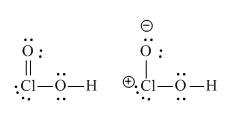
Concept explainers
Interpretation: The Lewis structure of the given oxyacids of chlorine using the formal charge and the possible resonance structure is to be identified.
Concept introduction: The Lewis symbols of the atoms indicate the total number of valence electrons surrounding the atom or the ions.
Formal charge is calculated by the formula,
To determine: The Lewis structure of all the resonance forms of
Answer to Problem 8.142AP
Solution
There are two resonating structures of
Explanation of Solution
Explanation
The
Therefore, the electronic configuration of oxygen is
Thus, the number of valence electrons of oxygen is
The atomic number of chlorine is
Therefore, the electronic configuration of chlorine is
Thus, the number of valence electrons of chlorine is
The atomic number of hydrogen is
Therefore, the electronic configuration of hydrogen is
Thus, the number of valence electrons of hydrogen is
Thus, the total number of valence electrons of
Therefore, the possible Lewis structures of

Figure 1
Formal charge is calculated by the formula,
Therefore, the formal charge of chlorine on the right Lewis structure containing four nonbonding electrons and four bonding electrons is,
The formal charge of oxygen on the right Lewis structure containing six nonbonding electrons and two bonding electrons is,
The formal charge of chlorine on the left Lewis structure containing six nonbonding electrons and two bonding electrons is,
The formal charge of oxygen on the left Lewis structure containing four nonbonding electrons and four bonding electrons is,
Therefore, the left Lewis structure is correct.
The total number of valence electrons of
Therefore, the possible Lewis structures of

Figure 2
The formal charge of chlorine on the right Lewis structure containing four nonbonding electrons and four bonding electrons is,
The formal charge of oxygen on the right Lewis structure containing six nonbonding electrons and two bonding electrons is,
The formal charge of chlorine on the left Lewis structure containing four nonbonding electrons and six bonding electrons is,
The formal charge of oxygen on the left Lewis structure containing four nonbonding electrons and four bonding electrons is,
The left Lewis structure is correct and the two structures are the resonating structures of each other.
The total number of valence electrons of
Therefore, the possible Lewis structures of

Figure 3
The formal charge of chlorine on the Lewis structure containing two nonbonding electrons and eight bonding electrons is,
The formal charge of chlorine on the Lewis structure containing two nonbonding electrons and six bonding electrons is,
The formal charge of oxygen on the Lewis structure containing six nonbonding electrons and two bonding electrons is,
The formal charge of chlorine on the Lewis structure containing two nonbonding electrons and ten bonding electrons is,
The formal charge of oxygen on the left Lewis structure containing four nonbonding electrons and four bonding electrons is,
Therefore, the extreme right Lewis structure is correct and the three structures are the resonating structures of each other.
Conclusion:
There are two resonating structures of
Want to see more full solutions like this?
Chapter 8 Solutions
EBK CHEMISTRY: THE SCIENCE IN CONTEXT,
- Identify the compound with the longest carbon - nitrogen bond. O CH3CH2CH=NH O CH3CH2NH2 CH3CH2C=N CH3CH=NCH 3 The length of all the carbon-nitrogen bonds are the samearrow_forwardIdentify any polar covalent bonds in epichlorohydrin with S+ and 8- symbols in the appropriate locations. Choose the correct answer below. Η H's+ 6Η Η Η Η Η Ηδ Η Ο Ο HH +Η Η +Η Η Η -8+ CIarrow_forwardH H:O::::H H H HH H::O:D:D:H HH HH H:O:D:D:H .. HH H:O:D:D:H H H Select the correct Lewis dot structure for the following compound: CH3CH2OHarrow_forward
- Rank the following compounds in order of decreasing boiling point. ннннн -С-С-Н . н-с- ННННН H ΗΤΗ НННН TTTĪ н-с-с-с-с-о-н НННН НН C' Н н-с-с-с-с-н НН || Ш НННН H-C-C-C-C-N-H ННННН IVarrow_forwardRank the following compounds in order of decreasing dipole moment. |>||>||| ||>|||>| |>|||>|| |||>||>| O ||>>||| H F H F H c=c || H c=c F F IIIarrow_forwardchoose the description that best describes the geometry for the following charged species ch3-arrow_forward
- Why isn't the ketone in this compound converted to an acetal or hemiacetal by the alcohol and acid?arrow_forwardWhat is the approximate bond angle around the nitrogen atom? HNH H Harrow_forwardOH 1. NaOCH2CH3 Q 2. CH3CH2Br (1 equiv) H3O+ Select to Draw 1. NaOCH2 CH3 2. CH3Br (1 equiv) heat Select to Edit Select to Drawarrow_forward
- Complete and balance the following half-reaction in acidic solution. Be sure to include the proper phases for all species within the reaction. S₂O₃²⁻(aq) → S₄O₆²⁻(aq)arrow_forwardQ Select to Edit NH3 (CH3)2CHCI (1 equiv) AICI 3 Select to Draw cat. H2SO4 SO3 (1 equiv) HO SOCl2 pyridine Select to Edit >arrow_forwardComplete and balance the following half-reaction in basic solution. Be sure to include the proper phases for all species within the reaction. Zn(s) → Zn(OH)₄²⁻(aq)arrow_forward
 ChemistryChemistryISBN:9781305957404Author:Steven S. Zumdahl, Susan A. Zumdahl, Donald J. DeCostePublisher:Cengage Learning
ChemistryChemistryISBN:9781305957404Author:Steven S. Zumdahl, Susan A. Zumdahl, Donald J. DeCostePublisher:Cengage Learning ChemistryChemistryISBN:9781259911156Author:Raymond Chang Dr., Jason Overby ProfessorPublisher:McGraw-Hill Education
ChemistryChemistryISBN:9781259911156Author:Raymond Chang Dr., Jason Overby ProfessorPublisher:McGraw-Hill Education Principles of Instrumental AnalysisChemistryISBN:9781305577213Author:Douglas A. Skoog, F. James Holler, Stanley R. CrouchPublisher:Cengage Learning
Principles of Instrumental AnalysisChemistryISBN:9781305577213Author:Douglas A. Skoog, F. James Holler, Stanley R. CrouchPublisher:Cengage Learning Organic ChemistryChemistryISBN:9780078021558Author:Janice Gorzynski Smith Dr.Publisher:McGraw-Hill Education
Organic ChemistryChemistryISBN:9780078021558Author:Janice Gorzynski Smith Dr.Publisher:McGraw-Hill Education Chemistry: Principles and ReactionsChemistryISBN:9781305079373Author:William L. Masterton, Cecile N. HurleyPublisher:Cengage Learning
Chemistry: Principles and ReactionsChemistryISBN:9781305079373Author:William L. Masterton, Cecile N. HurleyPublisher:Cengage Learning Elementary Principles of Chemical Processes, Bind...ChemistryISBN:9781118431221Author:Richard M. Felder, Ronald W. Rousseau, Lisa G. BullardPublisher:WILEY
Elementary Principles of Chemical Processes, Bind...ChemistryISBN:9781118431221Author:Richard M. Felder, Ronald W. Rousseau, Lisa G. BullardPublisher:WILEY





